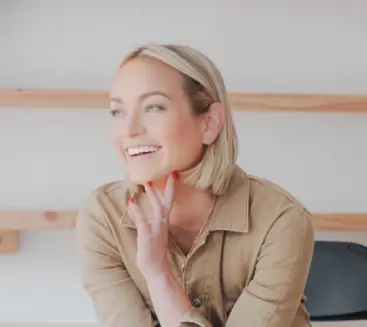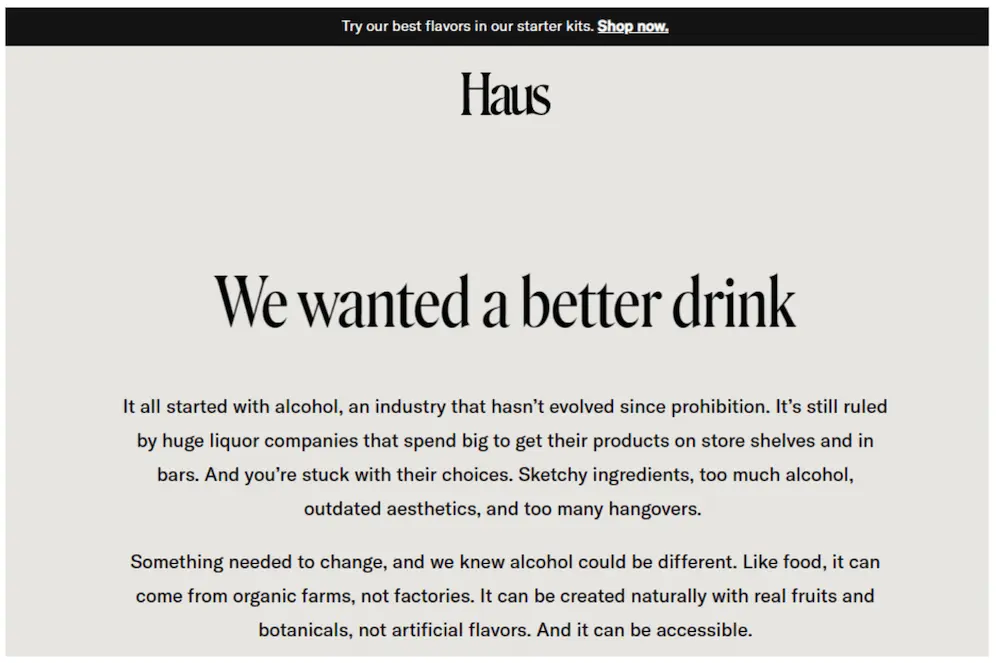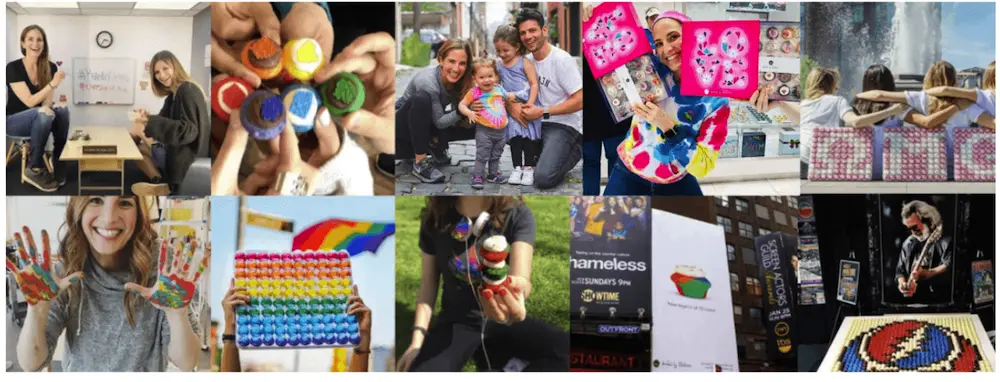Brand storytelling: 7 archetypes, 4 examples, and 3 tips for ecommerce marketers

The instinct to connect is part of each of us. When we meet new people—or even new brands—our first impulse is to understand the context before we feel a connection.
This means that with every new meeting of a person or brand, each of us is instinctually asking: What’s your story?
Scientific evidence even shows why storytelling forges connections between people.
According to researcher Paul Zak: “As social creatures who regularly affiliate with strangers, stories are an effective way to transmit important information and values from one individual or community to the next.”
Stories are an effective way to transmit important information.
Researcher Paul Zak
The power of storytelling has obvious implications for ecommerce companies, as teams work to humanize their brand, share the story behind their business, and create a meaningful connection with an ideal customer segment. This segment can be created through the correct data and personalizing the user experience.
But not any old story will sell your brand to new customers.
To create a resonant story, you need to frame it with a key story archetype and tie your founder’s journey with your mission.
Learn the 7 basic archetypes of stories
According to Christopher Booker, author of The Seven Basic Plots: Why We Tell Stories, you can distill every story into one of 7 basic archetypes:
- Rags to riches: This is the classic Cinderella story—the rise of a protagonist who starts from obscurity.
- The quest, or “hero’s journey”: Think Star Wars—an outsider protagonist feels the call of big-time dreams.
- Voyage and return: The desert island story is a classic take on a “voyage and return.” Specifically, it focuses on how exposure to a different world changes us.
- Rebirth: Similar to a “voyage and return,” a rebirth focuses on what a character learns. Think A Christmas Carol.
- Comedy: In ages past, a “comedy” used to refer to any harrowing story that ended on an uplifting, harmonious note.
- Tragedy: Reverse the comedy and you have a “tragedy”—a cautionary tale that ends poorly.
- Overcoming the monster: Think Beowulf—the classic tale of overcoming odds that seem fantastical and overwhelming.
Knowing these archetypes gives you a solid foundation for brand storytelling. But Zak suggests every story—regardless of archetype—requires two essential elements to build a connection:
- Capturing and holding your audience’s attention
- “Transporting” the listener into the characters’ world
If you’re writing a screenplay, capturing and transporting your audience is a relatively straightforward process. But how does a founder—with a nonfiction story to tell—accomplish something as enthralling as “overcoming the monster”?
4 storytelling examples from ecommerce brands
The first step in incorporating basic storytelling archetypes into your brand’s marketing efforts is to get a feel for how other founders do it successfully.
Haus: slaying the big bottler dragons
Haus is an alcohol brand that sells naturally-made, low-alcohol mixers. Right off the bat, they’ve baked their unique selling proposition—“farm-to-bottle aperitifs, delivered to your door”—directly into their messaging.
But their brand story goes even deeper than “farm-to-bottle.” According to Haus, alcohol was an industry that “hasn’t evolved since prohibition.”
The monster of this story? “Huge liquor companies,” writes Haus, “that spend big to get their products on store shelves and in bars. And you’re stuck with their choices.”

Haus succeeds by writing a key differentiator into their “overcoming-the-monster” story. They position themselves as an alternative to massive bottling companies. If the problem is impersonal liquor based on appeasing the masses, Haus’s farm-to-bottle aperitifs are the sword that will slay the dragon.
But they don’t stop there. On their website, Haus continues, “Our team blends every bottle at our warehouse in Sonoma County, and ships straight to you.”
Notice the specifics—not just any county, but Sonoma County. Without saying so, the intimation is simple: this isn’t a nameless, faceless bottler.
Specificity is an element you’ll see the best brands include: they explain why they got into business in the first place, and how their products and actions reflect that story.
“For us, storytelling gets into the why behind why we source the ingredients we do. It’s why we still hand-make the product ourselves instead of outsourcing,” says Helena Price Hambrecht, co-founder and CEO of Haus. “It’s why we put so much into aperitif education and collaborating with our community. Your story should be the backbone of how you build your business. Telling your story only goes so far if it’s not reflected in your actions.”
Your story should be the backbone of how you build your business.
Helena Price Hambrecht, co-founder and CEO of Haus
All the elements are there: the human connection behind why the brand exists, and the business connection between a story archetype and the products they offer.
Dagne Dover: embracing the journey
In Zak’s research, he discovered about half of the stories in Hollywood adhered to one of the classic archetypes: the “hero’s journey.”
The “hero’s journey” doesn’t work without first establishing an emotional connection—audiences won’t care about Aladdin’s wish-granting genie if we don’t first see him stealing bread to eat. Transparency is necessary.
Transparency is necessary.
Jessy Dover, co-founder and chief creative officer of handbag brand Dagne Dover, seems to understand story structure instinctually. She built story structure into her brand from the start, wisely weaving “problem-solving” bags into the brand’s larger impact story and positioning these products as the antidote to poor corporate responsibility:

According to Dover, the story structure here isn’t a coincidence. Dover believes in the power of stories—especially in using transparency to connect with others. Notice how Dagne Dover’s brand story page sneaks in elements of the hero’s journey:

“My personal opinion is that vulnerability and honesty hold power. My mom, an English teacher and librarian, always said that a good story has a beginning, middle, and end. Considering these things, my method of storytelling is to reveal myself—however embarrassing it may be—and consciously share my life story so that people understand why I am who I am, using my high highs and low lows as markers,” Dover says.
A good story has a beginning, middle, and end.
Jessy Dover, co-founder and chief creative officer of handbag brand Dagne Dover
It works the same for your brand’s founder. Look at the reasons your brand exists and see which storytelling archetypes fit that story. Now you have the framework to communicate your brand’s ethos.
Jones Road Beauty: the story of transformation
Stories of transformation are popular with every audience. When the protagonist learns transformational knowledge, we can’t wait to see what’s next.
Makeup brand Jones Road Beauty embraces the “rebirth” archetype with its own brand hero, founder Bobbi Brown, whose expertise comes from a lifetime of creating makeup for all skin types.
Jones Road Beauty happily leans on their founder’s expertise in their brand marketing and social feeds:

“When it comes to us translating [Brown’s] passion, knowledge, and stories into our branding, it’s actually quite simple,” says Joanne Coffey, assistant manager of retention marketing at Jones Road Beauty.
“We sit, listen, and ask questions. Bobbi unveils what the product is intended for, who it’s intended for, which products it goes well with, and more. We work as a team to break down her thoughts and use these briefs across social, email + SMS, PR, website, etc. It’s a team effort and we all work together to make sure Jones Road is exactly what Bobbi envisions.”
It’s a team effort and we all work together to make sure Jones Road is exactly what Bobbi envisions.
Joanne Coffey, assistant manager of retention marketing at Jones Road Beauty
Using Brown’s industry expertise to inform the brand does more than incorporate her transformative knowledge of makeup artistry. It also creates a differentiator: Consumers who want makeup products at the exacting Bobbi Brown standard know they only have one place to go.
Baked By Melissa: rags to riches
The “rags-to-riches” archetype resonates with us because we all want greater things for ourselves—and Melissa Ben-Ishay of the bakery Baked by Melissa appreciates a good Cinderella story.
Her brand’s story echoes the classic “rags to riches” archetype to a T.
Ben-Ishay doesn’t start her founder’s story with her first cake. She starts it with an anecdote about being fired.
Ben-Ishay doesn’t start her founder’s story with her first cake. She starts it with an anecdote about being fired.
“I certainly wasn’t passionate about my job,” writes Ben-Ishay. “And I guess it was clear to the people at the company because—I was fired.”
If it ended there, like Cinderella before the ball, it’s an incomplete story. But also like Cinderella, Ben-Ishay had someone looking out for her. Her brother encouraged her to bake while he figured out the business side.
Next step? The ball.

You don’t have to love cupcakes for Melissa’s story to resonate. Baked By Melissa wisely connects Melissa’s mission with its current goals: a female-founded company striving to “make life sweeter.”
It’s impossible not to root for that.
3 tips for telling resonant brand stories
What if you’re starting a new brand story from scratch? Let’s identify the key takeaways from the brands above and what they did to give their stories gut-level emotional appeal.
1. Give your main character something to strive for—and identify something that’s in the way
Every great story needs a protagonist. Let the founder be your main character—the “every person” starting with a dream or an obstacle.
Ben-Ishay is undoubtedly the main character of Baked By Melissa. But if it was just a story of cupcakes—and not overcoming the challenges along the way—the connection between brand and consumer wouldn’t be as strong.
Or, to hear an expert tell it:
“It can be helpful to think of a few key areas that make you unique––whether you’re balancing entrepreneurship with parenthood or feel strongly about a specific cause, weaving that into your narrative can be an effective way to connect with readers and followers,” says Aja Singer, branding and creative strategist. “It’s much easier to form a bond with a person than a brand.”
It’s much easier to form a bond with a person than a brand.
Aja Singer, branding and creative strategist
2. Be clear about what makes your story different
There’s no connection without first capturing attention. And there’s no attention until you differentiate yourself.
What makes you different?
- Are you farm-to-bottle, unlike the big bottlers?
- Is Bobbi Brown your company’s makeup expert?
- Did you start a bakery after getting fired?
Find that specific experience that differentiates your brand’s founding story from anyone else’s, and make it a central focus of your story.
3. Invigorate your ads with storytelling archetypes
Don’t think of ads as sales pitches. Think of them as hooks to your story—a way to get people to start your sales funnel.
Use education and storytelling to create genuine connections before the pitch. This way, you aren’t tricking people into becoming a customer, but educating and entertaining them with your brand story all along the way.
This makes for more engaged customers overtime, which then improves your cost of customer acquisition, too!
According to Cody Plofker, director of ecommerce at Jones Road Beauty, this type of ecommerce advertising is called “brand-first performance.”
What’s your story?
Every business and brand has a plethora of stories to tell. Don’t make the mistake of assuming your founder story is “boring.” Instead, lean into your story and use it as a selling point for your brand.
- Find the dragon you’re trying to slay.
- Pick the archetype that suits you best.
- Tell people what makes you different.
- Connect your brand’s mission to a big-time idea.
Once you do, you’re ready to tell your founder’s story with a marketing platform capable of building personal moments for your brand.

Related content

AI customer service is expanding fast in 2026. Learn how brands use AI to improve efficiency, customer satisfaction, and loyalty, and unlock new revenue opportunities.

See how Customer Hub, Customer Agent, and Helpdesk powered faster support, reduced tickets, and boosted revenue during Klaviyo Service’s first BFCM.

Post-purchase experiences are where customer loyalty begins. Learn how to automate and personalize them to grow your B2C brand